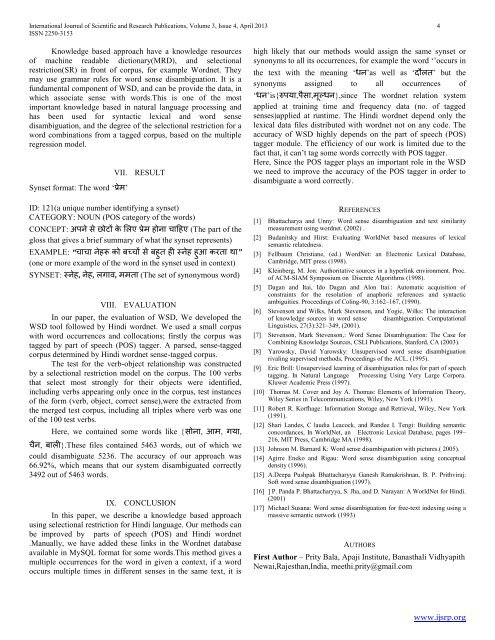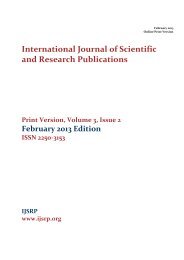Word Sense Disambiguation Using Selectional Restriction - Ijsrp.org
Word Sense Disambiguation Using Selectional Restriction - Ijsrp.org
Word Sense Disambiguation Using Selectional Restriction - Ijsrp.org
Create successful ePaper yourself
Turn your PDF publications into a flip-book with our unique Google optimized e-Paper software.
International Journal of Scientific and Research Publications, Volume 3, Issue 4, April 2013 4<br />
ISSN 2250-3153<br />
Knowledge based approach have a knowledge resources<br />
of machine readable dictionary(MRD), and selectional<br />
restriction(SR) in front of corpus, for example <strong>Word</strong>net. They<br />
may use grammar rules for word sense disambiguation. It is a<br />
fundamental component of WSD, and can be provide the data, in<br />
which associate sense with words.This is one of the most<br />
important knowledge based in natural language processing and<br />
has been used for syntactic lexical and word sense<br />
disambiguation, and the degree of the selectional restriction for a<br />
word combinations from a tagged corpus, based on the multiple<br />
regression model.<br />
Synset format: The word ‘प्रेभ’<br />
VII. RESULT<br />
ID: 121(a unique number identifying a synset)<br />
CATEGORY: NOUN (POS category of the words)<br />
CONCEPT: अऩने से छोटों िे लरए प्रेभ होना चाहहए (The part of the<br />
gloss that gives a brief summary of what the synset represents)<br />
EXAMPLE: “चाचा नेहरू िो फच्चों से फहुत ही स्नेह हुआ ियता था”<br />
(one or more example of the word in the synset used in context)<br />
SYNSET: स्नेह, नेह, रगाव, भभता (The set of synonymous word)<br />
VIII. EVALUATION<br />
In our paper, the evaluation of WSD, We developed the<br />
WSD tool followed by Hindi wordnet. We used a small corpus<br />
with word occurrences and collocations; firstly the corpus was<br />
tagged by part of speech (POS) tagger. A parsed, sense-tagged<br />
corpus determined by Hindi wordnet sense-tagged corpus.<br />
The test for the verb-object relationship was constructed<br />
by a selectional restriction model on the corpus. The 100 verbs<br />
that select most strongly for their objects were identified,<br />
including verbs appearing only once in the corpus, test instances<br />
of the form (verb, object, correct sense),were the extracted from<br />
the merged test corpus, including all triples where verb was one<br />
of the 100 test verbs.<br />
Here, we contained some words like {सोना, आभ, गमा,<br />
चैन, फारी}.These files contained 5463 words, out of which we<br />
could disambiguate 5236. The accuracy of our approach was<br />
66.92%, which means that our system disambiguated correctly<br />
3492 out of 5463 words.<br />
IX. CONCLUSION<br />
In this paper, we describe a knowledge based approach<br />
using selectional restriction for Hindi language. Our methods can<br />
be improved by parts of speech (POS) and Hindi wordnet<br />
.Manually, we have added these links in the <strong>Word</strong>net database<br />
available in MySQL format for some words.This method gives a<br />
multiple occurrences for the word in given a context, if a word<br />
occurs multiple times in different senses in the same text, it is<br />
high likely that our methods would assign the same synset or<br />
synonyms to all its occurrences, for example the word ‘’occurs in<br />
the text with the meaning ‘धन’as well as ‘दौरत’ but the<br />
synonyms assigned to all occurrences of<br />
‘धन’is{रुऩमा,ऩैसा,भूल्धन},since The wordnet relation system<br />
applied at training time and frequency data (no. of tagged<br />
senses)applied at runtime. The Hindi wordnet depend only the<br />
lexical data files distributed with wordnet not on any code. The<br />
accuracy of WSD highly depends on the part of speech (POS)<br />
tagger module. The efficiency of our work is limited due to the<br />
fact that, it can’t tag some words correctly with POS tagger.<br />
Here, Since the POS tagger plays an important role in the WSD<br />
we need to improve the accuracy of the POS tagger in order to<br />
disambiguate a word correctly.<br />
REFERENCES<br />
[1] Bhattacharya and Unny: <strong>Word</strong> sense disambiguation and text similarity<br />
measurement using wordnet. (2002) .<br />
[2] Budanitsky and Hirst: Evaluating WorldNet based measures of lexical<br />
semantic relatedness.<br />
[3] Fellbaum Christiane, (ed.) <strong>Word</strong>Net: an Electronic Lexical Database,<br />
Cambridge, MIT press (1998).<br />
[4] Kleinberg, M. Jon: Authoritative sources in a hyperlink environment. Proc.<br />
of ACM-SIAM Symposium on Discrete Algorithms (1998).<br />
[5] Dagan and Itai, Ido Dagan and Alon Itai.: Automatic acquisition of<br />
constraints for the resolution of anaphoric references and syntactic<br />
ambiguities. Proceedings of Coling-90, 3:162–167, (1990).<br />
[6] Stevenson and Wilks, Mark Stevenson, and Yogic, Wilks: The interaction<br />
of knowledge sources in word sense disambiguation. Computational<br />
Linguistics, 27(3):321–349, (2001).<br />
[7] Stevenson, Mark Stevenson,: <strong>Word</strong> <strong>Sense</strong> <strong>Disambiguation</strong>: The Case for<br />
Combining Knowledge Sources, CSLI Publications, Stanford, CA (2003).<br />
[8] Yarowsky, David Yarowsky: Unsupervised word sense disambiguation<br />
rivaling supervised methods, Proceedings of the ACL. (1995).<br />
[9] Eric Brill: Unsupervised learning of disambiguation rules for part of speech<br />
tagging. In Natural Language Processing <strong>Using</strong> Very Large Corpora.<br />
Kluwer Academic Press (1997).<br />
[10] Thomas M. Cover and Joy A. Thomas: Elements of Information Theory,<br />
Wiley Series in Telecommunications, Wiley, New York (1991).<br />
[11] Robert R. Korfhage: Information Storage and Retrieval, Wiley, New York<br />
(1991).<br />
[12] Shari Landes, C laudia Leacock, and Randee I. Tengi: Building semantic<br />
concordances, In WorldNet, an Electronic Lexical Database, pages 199–<br />
216, MIT Press, Cambridge MA (1998).<br />
[13] Johnson M. Barnard K: <strong>Word</strong> sense disambiguation with pictures.( 2005).<br />
[14] Agirre Eneko and Rigau: <strong>Word</strong> sense disambiguation using conceptual<br />
density (1996).<br />
[15] A.Deepa Pushpak Bhattacharyya Ganesh Ramakrishnan, B. P. Prithviraj:<br />
Soft word sense disambiguation (1997).<br />
[16] ] P. Panda P. Bhattacharyya, S. Jha, and D. Narayan: A WorldNet for Hindi.<br />
(2001)<br />
[17] Michael Susana: <strong>Word</strong> sense disambiguation for free-text indexing using a<br />
massive semantic network (1993)<br />
AUTHORS<br />
First Author – Prity Bala, Apaji Institute, Banasthali Vidhyapith<br />
Newai,Rajesthan,India, meethi.prity@gmail.com<br />
www.ijsrp.<strong>org</strong>
















